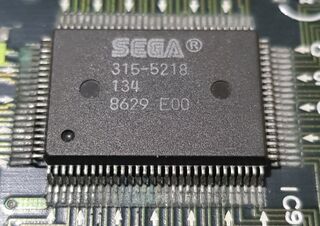SegaPCM
From Sega Retro
| This article needs cleanup. This article needs to be edited to conform to a higher standard of article quality. After the article has been cleaned up, you may remove this message. For help, see the How to Edit a Page article. |

|
| SegaPCM |
|---|
SegaPCM is the colloquial name of a PCM playback technology created by engineers at Studio 128 in 1985. It was originally implemented as discrete logic chips before being consolidated into a series of custom ASICs. It was mainly used in the Super Scaler series of high-end Sega arcade systems.
The technology is a 16-channel PCM sample mixer that uses an external sample ROM. While the mixer is stereo, only the volume of the left and right channels are independently controllable. Samples play at a fixed frequency and can be looped. It presumably allows up to 16MB of sample ROM provided by the board but has additional banking hardware with a 6-bit bank number leading to a total of up to 1GB of addressable sample data (assuming optimal conditions). The sample format is some 8-bit PCM (what form it is is not yet determined by anyone here). Whether or not it produces an analog or digital signal is also undetermined by editors here. Samples must be aligned to some offset (TODO determine).
SegaPCM was used exclusively by Studio 128's games through the System 32; other Sega arcade games (even those with music by the same composers), if they used sampled audio at all, provided a very basic DAC. Near the end of the decade the basic DAC would give way to more elaborate chips by other vendors (such as the NEC uPD7759 and Richo RF5C68). SegaPCM itself would eventually be phased out by the time Studio 128 became AM2, replaced by the Yamaha YMW258-F (aka "Sega MultiPCM"), beginning with the System Multi 32 arcade board.
Arcade boards with SegaPCM and part numbers
- Hang-On, Space Harrier, and Enduro Racer with YM2203: discrete logic chips
- Enduro Racer with YM2151: 315-5218
- All games: 315-5218[1]
- All games: 315-5218 (unconfirmed)
- All games: 315-5218 (unconfirmed)
Technical specifications
The SegaPCM has the following technical specifications:[2][1]
- Audio output: Stereo
- PCM audio channels: 16
- Audio bit depth: 12‑bit
- Sample rate: 31.25 kHz